 by "ttyymmnn" (ttyymmnn)
by "ttyymmnn" (ttyymmnn)
Published 10/31/2017 at 12:35
 by "ttyymmnn" (ttyymmnn)
by "ttyymmnn" (ttyymmnn)
Published 10/31/2017 at 12:35
Tags: planelopnik history
; Planelopnik
STARS: 7
!!! UNKNOWN CONTENT TYPE !!!
Welcome to
This Date in Aviation History
, getting of you caught up on milestones, important historical events and people in aviation from October 28 through October 31.
!!! UNKNOWN CONTENT TYPE !!!
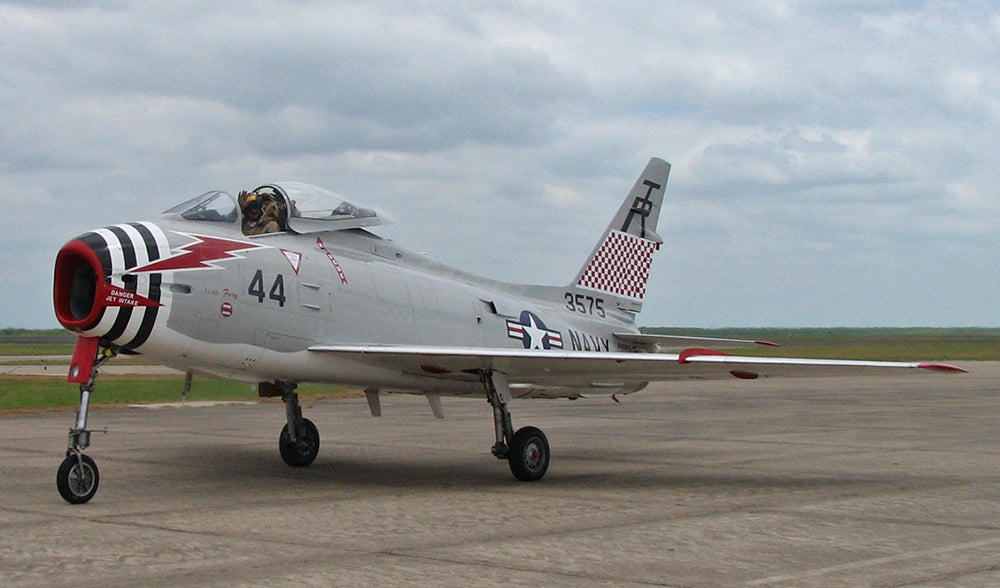
October 28, 1954 – The first flight of the North American FJ-4 Fury. The US Navy entered the jet age following the Second World War, first with the McDonnell FH Phantom , then the utterly unsuccessful Vought F6U Pirate , followed by the much more successful McDonnell F2H Banshee and Grumman F9F Panther . However, by the early 1950s, straight-winged fighters were being completely outclassed in the skies over Korea by the faster and more maneuverable swept-wing Russian MiG-15 . The Navy had a couple of new fighters under development in the Vought F7U Cutlass and Grumman F9F Cougar , but those planes would not be ready in time. They needed a more modern fighter fast, so, in a somewhat uncharacteristic move, the Navy looked to the US Air Force to quickly fill the void in their combat line up. The North American F-86 Sabre had entered Air Force service in 1949, and it was the first US aircraft that could match the MiG, ultimately becoming one of the best fighters of the Korean War. And, in an ironic twist, the Sabre itself had started out as a design for the US Navy, the North American FJ-1 Fury . But the land-based Sabre needed significant modifications to handle the specific requirements of Naval service, including the addition of catapult gear, an arrester hook, folding wings and a lengthened nose gear to increase the angle of attack during takeoff and landing. This aircraft was designated FJ-2, and the Navy’s need for the new fighter was so urgent that they ordered 200 before the prototype had even flown. The FJ-2 was soon upgraded to the FJ-3 with the addition of a more powerful engine. The Fury served the Navy well and over 700 were produced. But the modifications weren’t complete yet, and the FJ-4 became the ultimate development of the Fury line.
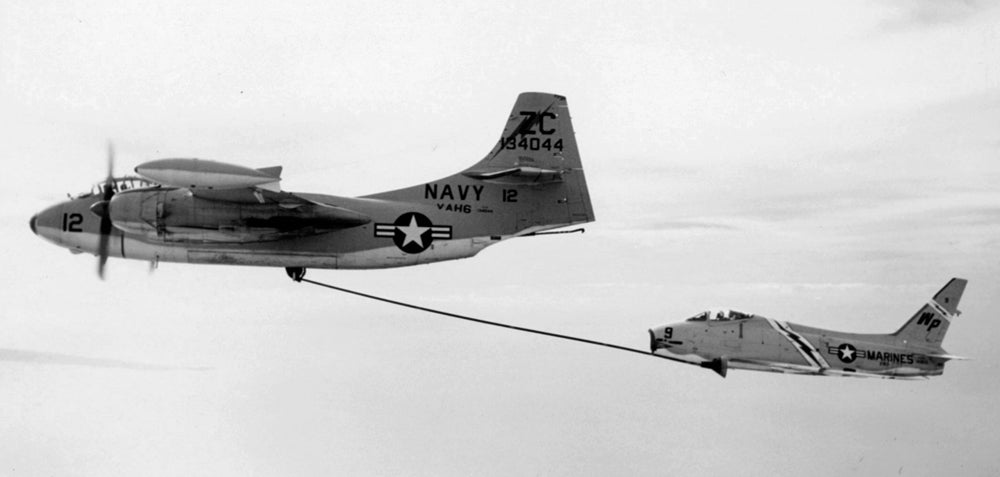
Where the FJ-2 and -3 looked every bit like a Sabre in US Navy livery, the FJ-4 bore a certain family resemblance but was an entirely new structural design. The wings were made thinner, though the overall area was increased to hold fuel, and the landing gear was redesigned and given a wider track. The fuselage was deepened and stretched to accommodate more fuel, and the cockpit was enlarged. To save weight, North American removed armor plating and decreased the ammunition load, which resulted in a 50% increase in range over the FJ-3. The Navy originally ordered 221 FJ-4s, with 71 of those aircraft converted to the FJ-4B fighter-bomber version. These had provisions to carry more external stores, including a single nuclear weapon. An additional order in 1956 brought the total number produced to 374. The FJ-4 entered service in 1955 and, with the exception of one Navy training squadron, the FJ-4 was flown exclusively by the US Marine Corps while the Navy trained on and operated the FJ-4B. In 1962, when the US military standardized the naming of aircraft, the FJ-4 became the F-1E, and the FJ-4B became the AF-1E. The Fury was eventually phased out in the 1960s, ending its service with units of the US Naval Reserve. (Photo by the author; US Navy photo)
!!! UNKNOWN CONTENT TYPE !!!

October 28, 1952 – The first flight of the Douglas A3D (A-3) Skywarrior. Beginning in WWII, heavy strategic bombing was the purview of the US Army Air Forces, and then the US Air Force following the war. The US Navy had historically focused on fighters and attack aircraft but, by the 1950s, they wanted to get into the strategic bombing business like their Air Force brethren. The Navy’s first foray into a large, carrier-based bomber was the North American AJ Savage , a hybrid bomber that was powered by two radial engines and one turbojet and was originally intended to carry a single nuclear bomb. But it soon became apparent that the Navy needed a jet-powered bomber to take over the role from the Savage, and they found a successor in the Douglas A-3 Skywarrior. Together, the two aircraft are the only strategic bombers operated in large numbers by the the US Navy. The story of the Skywarrior began in 1948, when the Navy began looking for a large, jet-powered strategic bomber that could operate from proposed United States -class super carriers that were under development. The new carriers would be roughly the same size as today’s Nimitz -class carriers, but without an island so they could accommodate large, heavy aircraft. Specifically, the Navy required a bomber that was capable of carrying 10,000 pounds of weapons or a single nuclear bomb and have a loaded weight of 100,000 lbs. Depsite the Navy’s request, Douglas engineer Ed Heinemann proposed an aircraft with a loaded weight of 68,000 pounds, making it the smallest proposal submitted to the Navy. But more importantly, it was capable of operating from existing carriers, and Heinemann’s smaller design proved prophetic when the super carrier project was canceled in 1949. Even though the Skywarrior was the smallest of the proposals, it was still the largest and heaviest aircraft ever to operate regularly from US carriers.
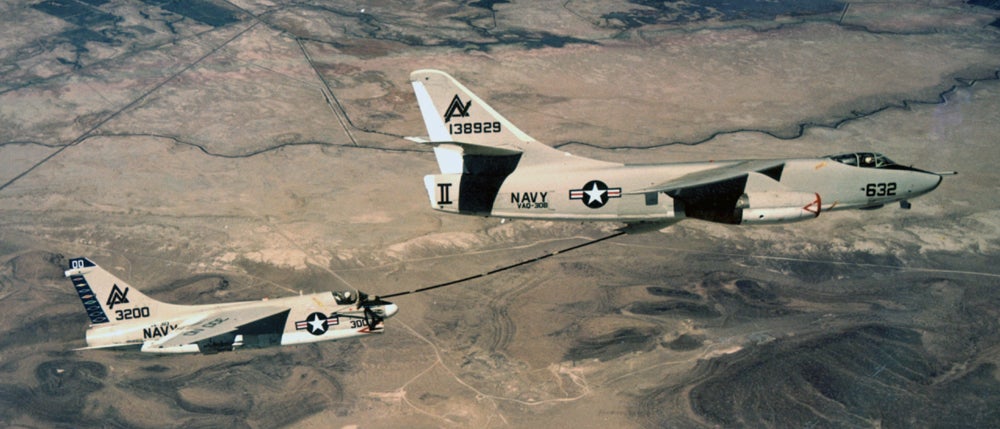
The Skywarrior was powered by two Pratt & Whitney J57 turbojets mounted on pods under the wings and had a top speed of 610 mph. In an effort to save weight, the crew of three was not supplied with ejection seats, though they were included in the B-66 Destroyer variant produced for the Air Force. With no easy way to bail out of the big bomber, Navy pilots joked that “A3D” meant “all three dead.” The Skywarrior was introduced in 1956 but, once the Navy’s Polaris submarines became operational in 1961, the Navy no longer had a need for a nuclear-armed deep strike aircraft. However, the size of the Skywarrior made it ideal for other missions. Its large internal bomb bay could carry 12,000 pounds of conventional ordnance, be filled with electronic spying equipment, or loaded with fuel. Douglas developed a reconnaissance version designated RA-3B and an electronic countermeasures variant known as the EA-3B, and both saw extensive service during the Vietnam War. An aerial refueling version was designated KA-3B, and a multi-mission version known as the EKA-3B could perform the dual role of electronic warfare and aerial refueling. And though the Navy’s strategic bombing role didn’t last that long, the amazing flexibility of the Skywarrior allowed it to become one of the longest-serving aircraft in US Navy history. Particularly, the EA-3B had such a long service life that some even participated in the Gulf War , but most of the 282 Skywarriors produced were retired from active service by the end of that year. (US Navy photos)
!!! UNKNOWN CONTENT TYPE !!!
!!! UNKNOWN CONTENT TYPE !!!
!!! UNKNOWN CONTENT TYPE !!!
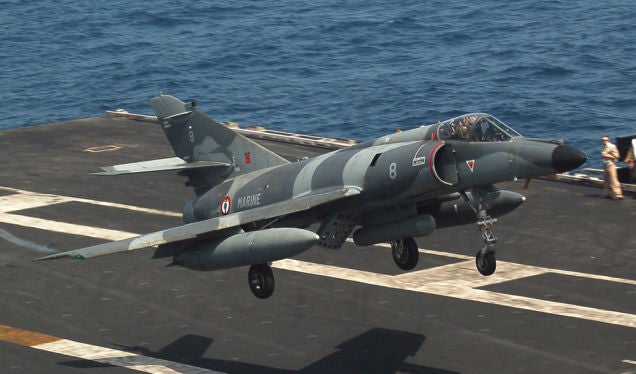
October 28, 1974 – The first flight of the Dassault-Breguet Super Étendard, a carrier-borne strike fighter that began as an upgraded version of the Dassault Étendard IV which first flew in 1958. The Super Étendard was essentially the same size as its predecessor, but had more power, a more efficient wing, increased range, and the ability to carry nuclear weapons. The Super Étendard entered service with the French Navy in 1978, and first saw action over Lebanon during Operation Olifant. The Super Étendard also served with Iraq, as well as Argentina, who used the aircraft armed with French-made Exocet missiles to sink HMS Sheffield during the Falklands War . The French Navy retired all of their Super Étendards in 2016 and replaced them with the Dassault Rafale M . (US Navy photo)
!!! UNKNOWN CONTENT TYPE !!!

October 28, 1972 – The first flight of the Airbus A300, the world’s first twin-engine widebody airliner. Development of the A300 started as a collaboration between Britain, France and West Germany which led to the formation of Airbus Industrie in 1970. The first A300 was powered by two General Electric CF6 high-bypass turbofans and, after entering service with Air France , the A300 became the first twin-engine airliner to be approved for extended operations over water ( ETOPS ), a certification that had previously only been given to aircraft with more than two engines. Production of the A300 ceased in 2006 after 561 airliners were built, and the aircraft remains popular with freight carriers such as UPS and FedEx. (Photo by Steve Fitzgerald via Wikimedia Commons )
!!! UNKNOWN CONTENT TYPE !!!
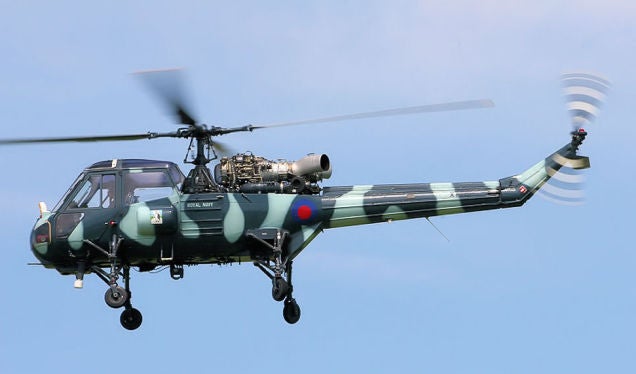
October 28, 1962 – The first flight of the Westland Wasp, a turbine-powered helicopter designed to perform the anti-submarine warfare role (ASW) while operating from the deck of smaller Royal Navy frigates. Along with the land-based Westland Scout , the Wasp was developed from the earlier Saro P.531 and was given a four-wheel castering undercarriage for stability. Its rotor blades could also be set at negative pitch to hold the Wasp on a rolling deck until it could be lashed down. The Wasp entered service in 1963, and could carry two torpedoes, two depth charges or a single Nuclear Depth Bomb . A total of 133 were produced, and the type was retired by the Royal Navy in 1988. (Photo by Tim Felce via Wikimedia Commons )
!!! UNKNOWN CONTENT TYPE !!!
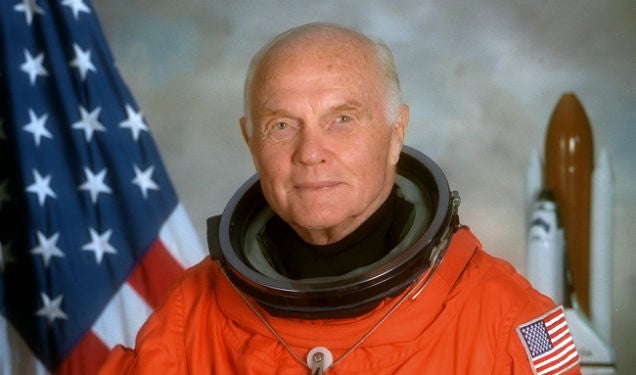
October 29, 1998 – Astronaut John Glenn returns to space. Seventy-seven years old and a US Senator at the time, this was Glenn’s second trip to space, having previously piloted Friendship 7 on February 20, 1962 as part of Project Mercury , becoming the fifth person and the first American to orbit the Earth (the two previous Mercury missions had been sub-orbital). With his flight on the Shuttle Discovery as part of STS-95 , Glenn became the oldest person to fly in space, but his flight was controversial, with some seeing it as no more than a political favor. However, Glenn did perform useful scientific research into geriatric studies during his nine days in orbit. (NASA photo)
!!! UNKNOWN CONTENT TYPE !!!
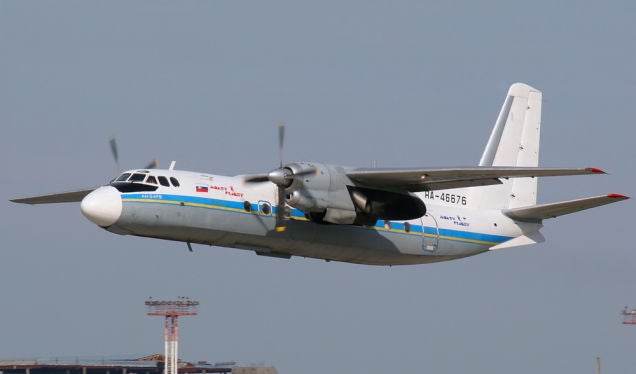
October 29, 1959 – The first flight of the Antonov An-24, a twin turboprop airliner that was designed to replace the aging Ilyushin Il-14 on short- to medium-range flights inside the Soviet Union. Like many other Russian aircraft, the An-24 was designed to operate from rough or unimproved airstrips, and nearly 1,400 were produced between 1959-1979, with some of that number built under license in China. Both the civilian and military versions of the An-24 were operated by a host of nations, and many remain in service today. (Photo by Gennady Misko via Wikimedia Commons )
!!! UNKNOWN CONTENT TYPE !!!
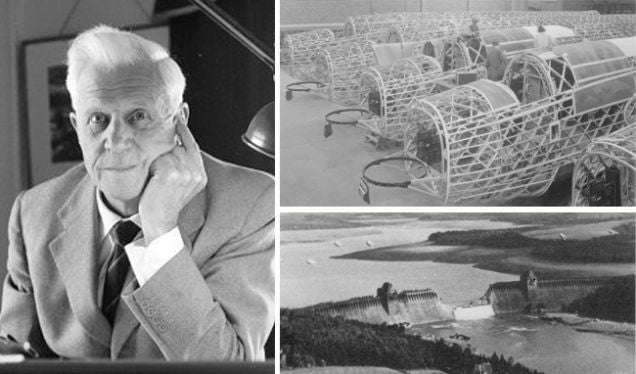
October 30, 1979 – The death of Sir Barnes Wallis. Born on September 26, 1887, Wallis was an English scientist, engineer and inventor best known for his contributions to the British war effort in WWII. Wallis pioneered the use of geodetic construction to strengthen British bombers such as the Vickers Wellington , and designed the famous skipping bombs that were used in Operation Chastise to destroy dams in the Ruhr Valley in an attempt to cripple German military production and disrupt hydroelectric power generation. He also developed the 6-ton Tallboy and 10-ton Grand Slam bombs that were used against German U-boat pens and other hardened structures. Following the war, Wallis dedicated himself to research into supersonic flight and the use of variable geometry wings, research which was later put to use in the Panavia Tornado .
!!! UNKNOWN CONTENT TYPE !!!
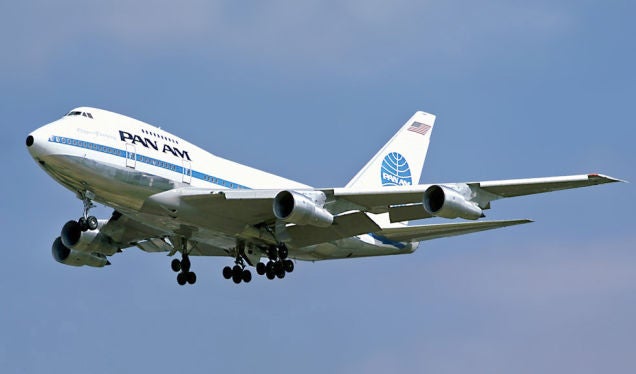
October 28-30, 1977 – Pan Am Flight 50 sets a world speed record for circumnavigation over both poles. To celebrate its 50th anniversary, Pan Am scheduled a circumnavigation of the globe that took off from San Francisco on October 28. Flight 50 flew across the North Pole to London, then on to Cape Town, South Africa, over the South Pole to Auckland, New Zealand, then back to San Francisco, hoping to break the previous record set in 1965 by a Boeing 707 nicknamed Pole Cat (N322F). One hundred twenty passengers paid for the trip on board the Clipper New Horizons (N533PA), a Boeing 747SP (Special Performance) variant shortened to increase range and speed. The flight totaled 54 hours, 7 minutes, 12 seconds of flying time, breaking Pole Cat’s record by more than eight hours and setting six new world records. (Photo by Steve Fitzgerald via Wikimedia Commons )
!!! UNKNOWN CONTENT TYPE !!!
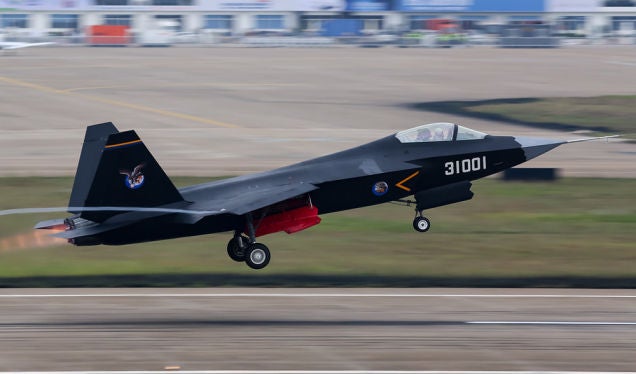
October 31, 2012 – The first flight of the Shenyang J-31, a fifth-generation multi-role fighter with stealth capability developed by the Shenyang Aircraft Corporation of China. Due to the secrecy of the Chinese government, the first photos of the completed prototype weren’t seen by the West until September 2012. The J-31 was unveiled to the public at the Zhuhai Airshow in November 2014, and it is still unclear whether or not the J-31 will be developed for naval use, and some countries, notably Pakistan, have expressed interest in obtaining the fighter. The full capabilities of the new fighter are not yet known, but it will most likely be an immediate match to American fourth-generation fighters, and possibly fifth-generation fighters such as the Lockheed Martin F-22 Raptor and F-35 Lightning II . (Photo by WC via Wikimedia Commons )
!!! UNKNOWN CONTENT TYPE !!!
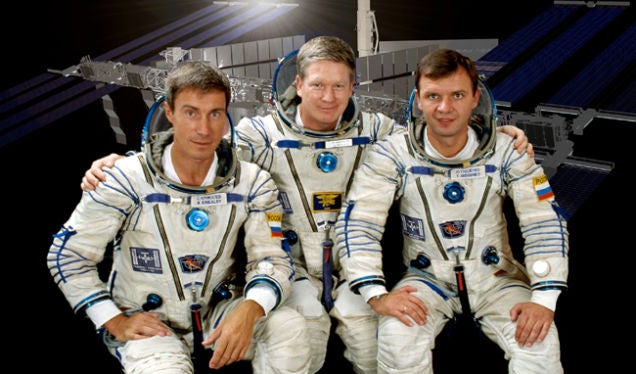
October 31, 2000 – The first crew to man the International Space Station (ISS) launches from Baikonur Cosmodrome in Kazakhstan. The mission, named Expedition 1 , had a three-man crew commanded by American astronaut William Shepherd and included Russian cosmonauts Yuri Gidzenko and Sergei K. Krikalev , both of whom had long-duration space experience on board the Russian space station Mir . Expedition 1 lasted 136 days, during which time the crew activated systems on board the ISS and unpacked equipment for future missions. The ISS has been continuously inhabited ever since. (NASA photo)
!!! UNKNOWN CONTENT TYPE !!!
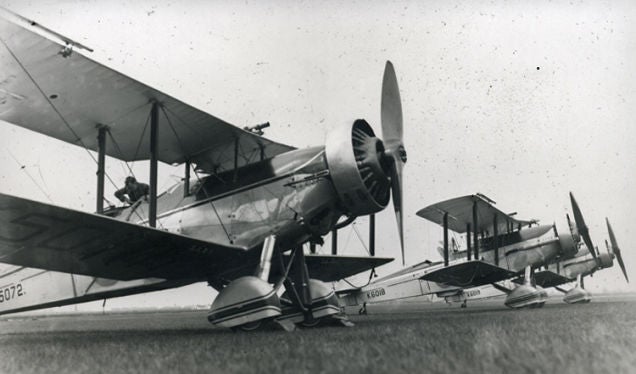
October 31, 1931 – The first flight of the Westland Wallace,
a two-seat biplane developed for the Royal Air Force during the period between the World Wars. Building on the success of the earlier
Westland Wapiti
, the Wallace featured a lengthened fuselage and more powerful engine, while the Wallace Mk II had spatted wheels and an optional enclosed cockpit. The Wallace entered service in 1933, with the majority flying with the Auxiliary Air Force, and served in all manner of roles. During the
Houston-Mount Everest Flight Expedition
of 1933, a Wallace was the first aircraft ever to fly over the summit of Mount Everest. Though it was obsolete at the outbreak of WWII, the Wallace continued to serve as a target tug and trainer for aircraft radio operators.
(UK Government photo)
!!! UNKNOWN CONTENT TYPE !!!
!!! UNKNOWN CONTENT TYPE !!!
!!! UNKNOWN CONTENT TYPE !!!
!!! UNKNOWN CONTENT TYPE !!!
!!! UNKNOWN CONTENT TYPE !!!
!!! UNKNOWN CONTENT TYPE !!!
!!! UNKNOWN CONTENT TYPE !!!
If you enjoy these Aviation History posts, please let me know in the comments. And if you missed any of the past articles, you can find them all at
Planelopnik History
. You can also find more stories about aviation, aviators and airplane oddities at
Wingspan
.
!!! UNKNOWN CONTENT TYPE !!!
 "RamblinRover Luxury-Yacht" (ramblininexile)
"RamblinRover Luxury-Yacht" (ramblininexile)
10/31/2017 at 12:51, STARS: 2
I’ve mentioned this before, but the best place of which I’m aware for a Barnes Wallis retrospective is the old Vickers facility, now museum, at Brooklands. Multiple of the geodetic bombers, a dambuster setup (IIRC) and other information and material.
 "ttyymmnn" (ttyymmnn)
"ttyymmnn" (ttyymmnn)
10/31/2017 at 13:20, STARS: 0
I’d love to see that. Wallis was a fascinating man.